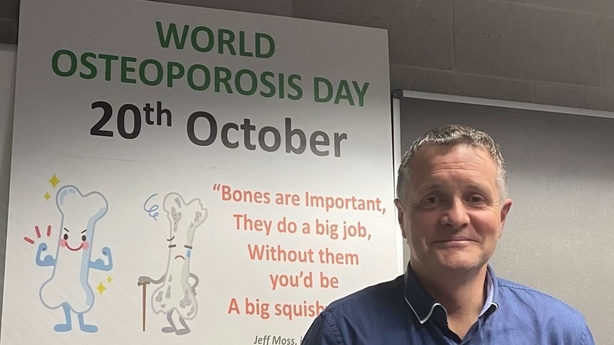The University of Galway has led international research showing up to half a million people in Ireland are living with osteoporosis.
The condition causes bones to become brittle resulting in skeletal failure.
Academics and clinicians are calling for an osteoporosis care programme to be put in place as a national priority.
The findings were released to coincide with World Osteoporosis Day and using data from the Irish health service spanning 20 years.
They show half of all women, and one in four men, aged 50 years and older will suffer an osteoporotic fracture before they die.
A postmenopausal woman's annual risk of fracture is greater than her combined risk of stroke, heart attack, invasive breast cancer and death from heart disease.
Professor John Carey is Professor is Consultant Physician in Medicine and Rheumatology and Clinical lead in DXA, Osteoporosis and Fracture Liaison Services, Galway University Hospitals.
"The key to prevention is the early detection of those most at risk. But what we require is a better use of current resources to benefit those at greatest risk, preventing more fractures, and eventually leading to substantial cost savings," Professor Carey said.
"DXA is the clinical test used to diagnose osteoporosis before a fracture occurs, as well as to estimate fracture risk and to monitor the effects of treatment. Access to quality DXA is a global problem, and Ireland is no different.
"Although Ireland has one of the highest rates of osteoporotic fracture and will have the one of the greatest increases in cost and incidence over the coming decade, it does not have a national programme or consider osteoporosis a national priority. It is very clear to those of us who lead treatment and research of the disease that we should. A national programme could greatly focus efforts to enhance current care and further improvements can be made without additional funding."
Professor Carey said the burden of illness related to osteoporosis - morbidity, mortality and economic costs - is similar to cardiovascular disease and cancer, but the importance of osteoporosis is often not understood, and therefore care is neglected.

A breakdown in findings show that more than 50,000 osteoporotic fractures occur each year in Ireland.
One in three men and one in five women die within a year following a hip fracture and the number of osteoporosis-related deaths in Ireland is similar to, or greater than, the number of deaths related to Covid-19.
Fractures are one of the leading causes of long-term admissions to nursing homes.
Researchers from the schools of Engineering, Computer Science and Medicine at the University of Galway carried out their analysis in collaboration with Tsinghua University in China, Oxford University in England, and Galway, Manorhamilton and Sligo University Hospitals.
New screening strategies
The University of Galway uses Dual-energy X-ray Absorptiometry (DXA) technology to measure bone density and develop new screening and testing strategies for early identification of osteoporosis.
The international research team says these strategies could reduce the number of unnecessary requests for a DXA test and increase referrals for those in need.
Early data suggests the financial cost of poor quality DXA scans in Ireland may be greater than the cost of providing high quality DXA which adheres to national and international standards, in particular avoiding testing and treating those at low risk and improving diagnosis and management of those with prior fractures.
Artificial Intelligence
Dr Attracta Brennan, School of Computer Science in University of Galway, said artificial intelligence can improve DXA detection of osteoporosis classification in older men and women.
"AI and big data are deeply intertwined - together, they offer powerful tools for risk prediction, modelling disease progression and prognosis, and supporting intervention recommendations.
Underpinned by AI, our DXA-MAP tool assesses the user’s probability of having osteoporosis in less than 30 seconds using age, gender, height and weight. AI and big data can be used to reduce unnecessary testing, improve patient care, reduce the burden of osteoporotic fractures and improve efficiency and reduce waste."







